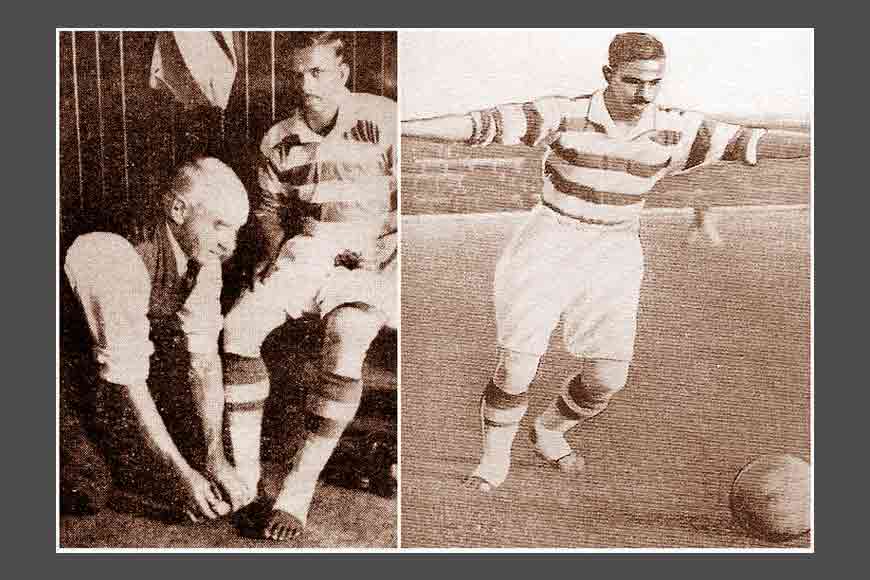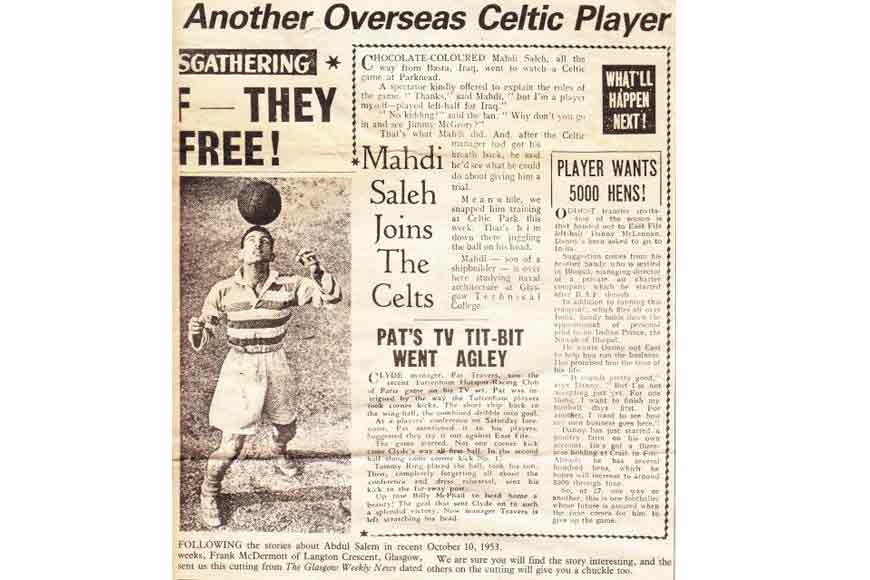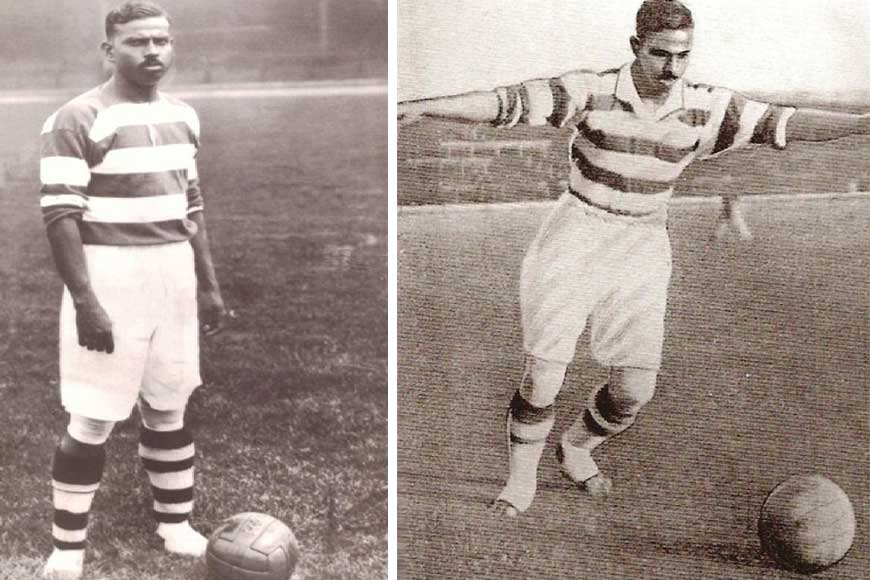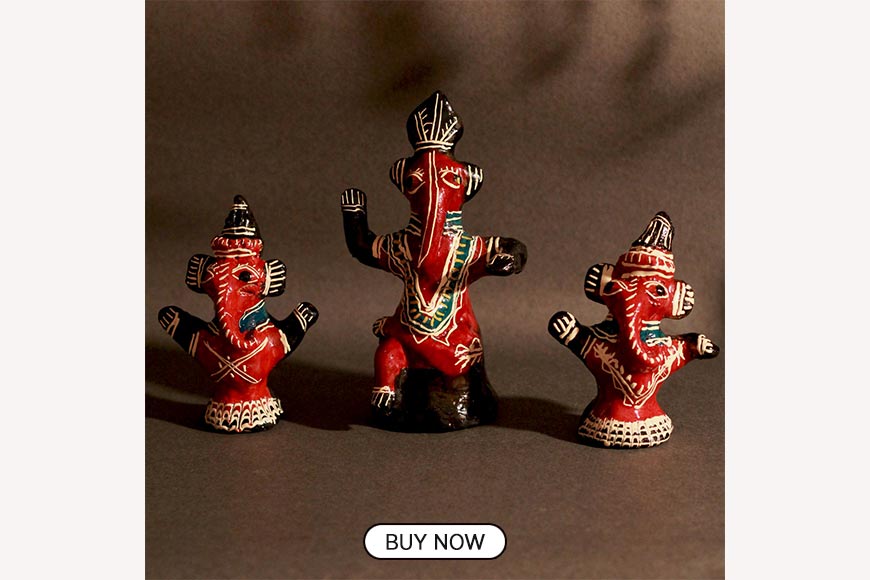First Indian footballer to play in Europe

Of late, both print and audio visual media have been rife with the ‘Maharaja’ of Kolkata’ aka the ‘King of the Off-side’ Sourav Ganguly ‘Dada’ beckoning the football-crazy nation to join him as the cult theme song, ‘Come on India, Let’s football…’ plays in the background. The seventh edition of the Hero Indian Super League is already underway. Over the next four months, crores of Indian viewers will watch rival teams from across the country battle it out for top honours in the country’s unrivalled football championship. There will be tales of loss and heartbreak, but there will also be stories of redemption and overcoming the odds. New heroes of football will emerge and take their rightful place alongside the legends of Indian football.
Football, the world’s most popular sport, has been synonymous with Kolkata at least for a century. Kolkata is regarded as the Mecca of football in India and the father of Indian football was none other than Nagendranath Sarbadhikary. But can anyone name the first Indian footballer who went abroad and played for a European club? Mohammed Salim was the first player from the Indian sub-continent to play for a European club, Celtic FC!
It turned out that Salim, along with his cousin Hasheem, went to Britain to try his luck in European football. Willie Maley was one of the most enigmatic managers to have ever managed the legendary Scottish club, Celtic.
Salim was born in 1904 in Metiaburuz, on the southern fringe of Calcutta. His father worked as menial laborer in a jute factory in the vicinity.Salim had no interest in formal academics, but he displayed great football skillssince childhood. There is an interesting anecdote about Mohammed Salim that highlights his boyhood obsession with the ball. His elder brother, Mohammed Aziz had a perfume counter in the erstwhile Hogg Market. His mother assigned Salim to deliver the lunch box to Aziz every day. Salim did as he was told but once he was taken ill and she had to ask another boy to deliver the box. In the evening when Aziz returned home he asked his motherwhy she had not mixed the curry with the rice as she did on other days. She was taken aback. Later it transpired that Salim practiced his shots substituting the lunch box for football on his way to deliver it to his brother. Hence the mixing!

The 1920s and 1930s were volatile period in the annals of India’s Independence movement. GandhiJi’s Non-cooperation Movement and demand for Swaraj was gaining ground and many Indian nationalists took to football to counter British jibes that Indians were incapable of home rule. In 1911, Mohun Bagan became the first Indian team to win the IFA Shield by defeating East Yorkshire Regiment 2-1. That was a historic moment for Indian football and this inspired Salim to pursue football seriously.
Salim joined Chittaranjan Club of Bowbazar, that was patronized by a group of educated Bengali middle-class football enthusiasts who instilled in Salim the fervent desire to beat the Europeans in their own game. Salim then joined the B team of Mohammedan Sporting Club for a short while but within that short span he was able to impress Pankaj Gupta, Bengal's legendary sports administrator. Struck by Salim’s exceptional talent, Gupta recruited him to play for his club, Sporting Union. Salim later went to play for East Bengal Clubbefore moving to the Aryans Club under the auspices of Santosh KumarMajumdar, a leading sportsman of his time.
Salim rejoined Mohammedan Sporting Club in 1934 and was finally part of their first team setup. He was instrumental in helping the Club to five league titles in a row. With Salim in their ranks, the Club for the first time in its history won the Calcutta Football League. For the next four years Mohammedan went on to win the coveted title with Salim spearheading the attack. Exceptionally talented, Salim was winning thousands of hearts with his ball control, dribbling, correct passes and lobs. After an impressive season with Mohammedan SC, he was invited to play two matches for All India XI against the Chinese Olympic side. He was so majestic in the first match that the opponents were full of praise for him.
In his first match against Hamilton, Celtic impressed with their football and dominated the game to wn by a 5-1 margin. He took a penalty and even managed to score one, thus becoming the first ever Indian-born footballer to play and score in European Football.
Advertisements were placed in several newspapers asking him to return before the start of the match. IFA, who were organising the two friendlies in India for the first time, put in a lot of to bring back Salim went in vain. It turned out that Salim, along with his cousin Hasheem, went to Britain to try his luck in European football. Willie Maley was one of the most enigmatic managers to have ever managed the legendary Scottish club, Celtic. It was only because of his progressive, neoteric thinking process that Celtic got their first and till date, only Indian footballer in their squad. Maley looked above colour or creed and that gave Celtic their first Asian sensation. The year was 1936 as Mohammed Salim reached Glasgow, he was introduced to Willie Malay by his cousin. Hasheem introduced Salim saying, “A great player from India has come by ship. Will you please take him on a trial? But there is a slight problem. Salim plays in bare feet.”
The Celtic coach laughed at the suggestion. The idea of a bare-footed amateur from India competing against Scottish professionals was difficult for Maley to believe but he agreed to give him a trial. Salim was asked to demonstrate his skill before 1,000 club members and three registered coaches. His ability, even in bare feet, astonished them. Maley was so impressed by his skill and technique that he immediately wanted to sign up Salim and make him play a couple of friendlies.And the rest, as they say, is history.

In his first match against Hamilton, Celtic impressed with their football and dominated the game to wn by a 5-1 margin. He took a penalty and even managed to score one, thus becoming the first ever Indian-born footballer to play and score in European Football. A week after the friendlies, Salim left Glasgow to be on his way back to Calcutta on the ship that brought him. Willie Maley wanted to sign him for the 1936/37 season and tried his best to persuade him to stay at Celtic. But Salim still wanted to leave Britain as he was homesick and was missing his family very badly.
The legend even lived in the 1950s in Beliaghata with his family but amid abject poverty. By that time, the major football clubs of Kolkata had forgotten about the brilliant player and his contribution to Indian football. Once he was taken seriously ill and his son, Rashid decided to write to Celtic FC.“I had no intention of asking for money. It was just a ploy to find out if Mohammed Salim was still alive in their memory. To my amazement, I received a letter from the club. Inside was a bank draft for £100. I was delighted, not because I received the money but because my father still holds a pride of place in Celtic. I have not even cashed the draft and will preserve it till I die. I just want my father's name to be put as the first Indian footballer to play abroad. That is the only thing that I want and nothing else.”
In 2010, Devayan Sen released a documentary titled, Indian Football in seven episodes. The very first episode of the film features an interview of Mohammed Salim’s son, Rashid, who laments that the Indian sports fraternity has remained indifferent to his father’s immense contribution to Indian football.Mohammed Salim remains an insignificantand buried name in the history of Indian football. Is this what he deserved after an illustrious career, ask his progeny.











